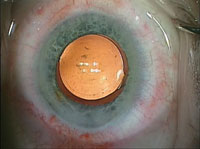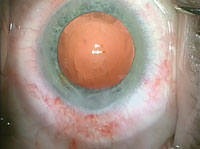Shift to femtosecond laser-assisted cataract surgery requires motivation, commitment
For one surgeon, procedure reduces time and energy by half.
Tenacity and a willingness to change are critical to a successful transition to femtosecond laser-assisted cataract surgery in an ophthalmic practice, according to one practitioner.
Surgeons adopting laser-assisted cataract surgery face a steep learning curve, but they can surmount that curve with keen dedication and focus, Michael A. Lawless, MD, said at APAO/SOE 2012 in Busan, Korea.
Dr. Lawless shared insights his practice has gained since installing an Alcon LenSx laser in March 2011. To date, Dr. Lawless has performed more than 400 laser-assisted cataract procedures; collectively, eight surgeons in the practice have performed more than 1,400 procedures. Safety profiles have increased significantly.
“Patients understand that a laser approach can add precision and safety to their cataract surgery,” Dr. Lawless told Ocular Surgery News.
Standardized measurements
The transition from manual to laser-assisted cataract surgery involves a paradigm shift in technique, with a standardized capsulotomy and corneal incision size and shape, Dr. Lawless said.
The primary incision is a three-plane reverse trapezoidal cut made 2.6 mm internally and 2.3 mm externally, with a length of 1.8 mm.
“I use a bi-manual approach for the subincisional cortex to avoid stress on the incision,” Dr. Lawless said.
The capsulotomy is 4.9 mm in diameter, with a laser energy setting of 15 µJ and a spot layer setting of 4:3.

A clear capsule and a nice, round capsulotomy result from femto use.

Well-positioned IOL with symmetrical capsulotomy and full overlap of IOL haptic.
Images: Lawless MA
“The key is a well-dilated pupil, at least 5 mm, and good docking with minimal time on the eye, less than 60 seconds,” he said.
A deep anterior chamber is not required to perform a continuous curvilinear capsulorrhexis.
Lens fragmentation is performed 5.2 mm on axis, with an anterior offset of 500 µm and a posterior offset of 1,100 µm.
The laser-assisted technique reduces phacoemulsification energy and time by about 50%, Dr. Lawless said.
“I use a blunt pre-chopper to separate the first and sometimes second quadrant, and there is less manipulation and stress on the zonules, useful in pseudoexfoliation and other vulnerable eyes,” he said.
Safety and efficacy
At APAO/SOE, Dr. Lawless presented data on the first 73 eyes in his practice treated with the LenSx laser and the last 40 eyes that underwent manual surgery. Data showed that 61% of eyes in the laser group and 40% of eyes in the manual surgery group were within 0.25 D of intended refraction.
Additionally, 71% of eyes in the laser group and 63% of eyes in the manual surgery group had uncorrected distance visual acuity of 20/25 or better.
“On a number of measures, the laser produced more accurate results with better [uncorrected visual acuity],” Dr. Lawless said. “It is worth noting that these manual results are extremely good and reflect a refined technique with a personalized surgeon factor, whereas the laser group was an initial series with an evolving technique and without the benefit of a personalized surgeon factor.”
Dr. Lawless said that data from the 491 laser cataract procedures he has performed to date show no anterior or posterior capsular tears, surpassing his 1% anterior capsule tear rate with manual surgery.
“Safety is enhanced and it is statistically significant. Improved accuracy is more subtle, but there is a trend toward better unaided vision,” Dr. Lawless said. – by Matt Hasson and David W. Mullin
